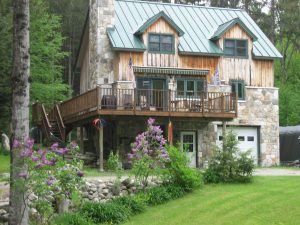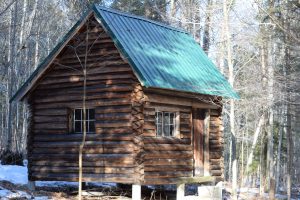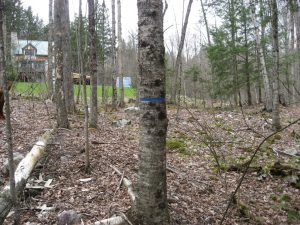
Active VWA members and Tree Farmers come in all shapes and sizes, just like their woods. For this issue, we peek in on VWA member and Tree Farmer Jock Irons.
Jock was born and raised in Bennington, where he stayed until he finished college. Then he moved to Alaska, where he stayed until moving back to Vermont in 2014. Jock now lives on the 41-acre property in Woodford with his mom, who is 93. The property originally belonged to friends of Jock’s father’s parents. The friends had no children of their own so they willed the property to whichever Irons boy (of Jock’s father or uncles) stayed in Bennington; Jock’s father, John, was the one who stayed and inherited the original 20 acres. At the same time, the Scott family had just completed a clearcut of their holdings in Woodford and Glastenbury, and they were making plans to transfer the land to the Forest Service to become part of the National Forest System. Before the sale was completed, the Forest Service contacted owners of adjoining lands to tell them to get their boundaries straight before everything was finalized. Jock’s father was also able to purchase an additional 20 acres, which, Jock noted, did not straighten the boundaries (“they’re worse than they were!”) but allowed John to acquire some additional acreage.

Jock discussed the house, nicknamed Stonehenge, and told about how it came into being. When he was still in Alaska, he was snowshoeing with his father, and Jock told John he wanted to build his retirement home on the family property. He described the house as “homegrown”: all of the 2x4s and 2x6s were rough-cut, milled, and dried on the land from spruce on the property. All of the kitchen cabinets are black cherry from the property. All of the stones on the exterior were collected by John for over 40 years, and the siding above the stone is board-and-batten spruce. John and Jock did the framing, and then Jock’s brother, a carpenter, joined the work party to help finish the house.
John had enrolled the property in the Tree Farm program in 1987, but his certification lapsed. Jock was contacted around 2015 or 2016 and asked if he still wanted the property in Tree Farm. Kyle Mason, then Forester for Bennington County (who has since moved to Rutland County) “roped” Jock into participating in the Tree Farm Committee and writing an article about his property for the Tree Farm newsletter.
“I became active in Tree Farm, and by my membership in Tree Farm, I learned about VWA and joined VWA after I joined Tree Farm, which is, apparently, the direction it goes most of the time. Very few VWA members subsequently join Tree Farm.”
The property is enrolled in Vermont’s Current Use program. The original management plan was done by a forester with Jock’s dad in 2012, and John’s original primary goal was harvesting saw timber with a secondary goal of managing wildlife. Since Jock has taken ownership, he has reversed those goals: he is managing for wildlife with timber harvest as a secondary goal.
“I have found, from all the years cutting firewood and tending the forest with my dad, I have developed a great appreciation for beautiful trees that will make beautiful sawlogs. And, so, I manage that way: I manage for straight trees with few limbs and a good species for sale to a mill. However, I don’t intend to actually cut them and make them into sawlogs; they’re sort of an aesthetic in themselves to me.”
Jock has seven stands on the property, four of which are enrolled in UVA. Two of those stands – one in UVA and one not in UVA – have plantation Norway Spruce that were planted during the Great Depression by the Civilian Conservation Corps. Jock’s father pruned them with a handsaw up 35 feet.

Both the stand of Norway Spruce in UVA as well as the adjacent stand of mixed conifer/northern hardwood are overstocked and require thinning because they are nearly inaccessible to a skidder. Jock talked with a couple of loggers, including a horse logger, but none were interested in the project, leaving Jock to tackle the thinning this winter. Jock’s forester has done the marking, so Jock plans to drop the trees and then leave them to rot. He talked about girdling some of the trees and leaving them standing as wildlife trees while felling the others and leaving them to rot on the forest floor, which is better for the forest.

Jock’s timber stand improvement (TSI) activities also include a technique called crop tree release, in which the forest landowner identifies the crop tree species of choice and then the individual trees of the tree species that are to be prioritized. Then the forest landowner looks at each individual tree’s canopy and removes neighboring trees that are competing with the priority trees for light. Crop tree release improves the forest by weeding out the less desirable specimens.
Another management activity that is taking Jock’s time is working on invasives. He has identified 17 species of invasives on the property, and Jock says he has most of them under control. A neighbor pointed out buckthorn, which, Jock said, “was the first I knew about invasives.” Jock’s father didn’t know about invasives at all and never talked about it.
Jock is a peer landowner with the Woods, Wildlife, and Warblers program and has visited with three other landowners to talk about their properties. In addition, Jock invited Steve Hagenbuch from Vermont Audubon to his property to do a bird habitat assessment on Jock’s land. Jock said his understory is a little bit lacking, but most of the assessment is predicated on a harvest.
“If you want to manage for wildlife, you’ve got to cut trees. And it’s something that a lot of people don’t understand. And I want to have as much diversity on my land as possible.”
Jock said the issue that is most important to him is invasive control – he said most forest landowners probably do not know they have an invasive problem, and they probably do. He flags a place where he finds invasives so that he can go back each year to check for new plants or a small piece of root that he left in the ground. The three that are not under control are buckthorn, Japanese knotweed, and garlic mustard. He has pulled out plants, treated the areas, and now holds constant watch to catch new seedlings. He has burned garlic mustard plants and cut down buckthorn stems, but he knows they are tenacious.
“Because so much of the Vermont forest is privately owned, that’s the only way that we’re going to get a handle on them. We’ll never eradicate them, but we can at least get a handle on it and slow things down a bit.”
Jock hosted a virtual tour of his forest back in October [insert link]. Inadvertently he had been prepping for it for years, taking walks and accumulating photos of different aspects of his property. He said he had been on a Zoom call with the VWA Board of Directors and Tree Farm Committee members, and people were bemoaning the fact that they could not do walks in the woods. Jock offered up a virtual walk, not really knowing what he was offering and others not knowing what they would be attending, but the group decided to give it a go. He shared a PowerPoint of photos and talked about the history of the property. People were interested in his work on invasives and vernal pools.
When asked about his time as a member of VWA, Jock noted a lot of overlap among Tree Farm, VWA, and VT Coverts. He said there is a good variety of events each year, and he has enjoyed participating in the past and looks forward to being able to participate in the future.
“Every forest in Vermont is different. Even a forest that’s only a mile from here is going to be different. I learn more every time I walk a new property.”
